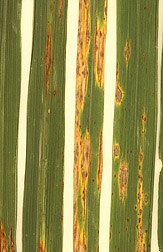Template:Taxobox begin Template:Taxobox begin placement Template:Taxobox domain entry Template:Taxobox regnum entry Template:Taxobox phylum entry Template:Taxobox subphylum entry Template:Taxobox classis entry Template:Taxobox ordo entry Template:Taxobox familia entry Template:Taxobox genus entry Template:Taxobox species entry Template:Taxobox end placement Template:Taxobox section binomial botany Template:Taxobox begin synonyms Template:Taxobox synonym entry simple Template:Taxobox end synonyms Template:Taxobox end
Magnaporthe grisea, also know as rice blast fungus, is a plant-pathogenic fungus that causes a disease affecting rice, and can also infect a number of other agriculturally important cereals. Rice blast causes economically significant crop losses annually: Each year it is estimated to destroy enough rice to feed more than 60 million people. The fungus is known to occur in 85 countries worldwide.
Biology and pathology
M. grisea is an ascomycete fungus. It is an extremely effective plant pathogen as it can reproduce both sexually and asexually to produce specialized infectious structures known as appressoria that infect aerial tissues and hyphae that can infect root tissues.
The asexual life cycle begins with the hyphae of the fungus undergo sporulation to produce fruiting structures called conidia which contain many spores. When these spores land on leaves and other aerial tissues of susceptible plants they germinate, developing the appressorium. The appressorium penetrates the plant cell by producing a penetration peg. Pressure in the appressorium increases and the structure explodes, forcing the penetration peg through the cell wall and into the cell. The fungus can then grow hyphae within the leaf and form lesions. Once established in the host plant the fungal hyphae can undergo asexual sporulation again. Sexual reproduction occurs when two strains of opposite mating types meet and form a perithecium in which ascospores develop. Once released, ascospores can develop appressoria and infect host cells. Spores are transmitted between plants by the wind.
In 2004 it was shown that in addition to infecting plants through the leaf, M. grisea can also infect the plant roots. The mode of root infection is the same as most root infecting fungi; it grows long hyphae that form an infection pad to gain entry to the root's interior. Once embedded in the root the fungus can produce resting structures. The blast fungus can also invade the plant's vascular system, growing inside the xylem and phloem and blocking the transport of nutrients and water from the roots, and produce lesions on aerial plant parts.
The fungus can kill or damage the plant in a number of ways. Aerial infection in seedlings is usually lethal because the young plants are unable to photosynthesize. Aerial infection in mature plants does not kill them, but reduced photosynthesis due to lesions on the leaf and use of photosynthate by the fungus greatly reduces yield. Infection of root and vascular tissues has the potential to kill the plant by cutting off the supply of water and nutrients to the root.
In 2005 the complete genome of M. grisea was sequenced. The organism is predicted to have over 11,000 genes. It is expected that the genome will reveal the mechanisms of fungal pathogen-plant interaction, in both aerial and root infection.
Distribution
Rice blast was probably first recorded as rice fever disease in China in 1637. It was later described as imochi-byo in Japan in 1704, and as brusone in Italy in 1828. The fungus is currently reported to be present in at least 85 countries. In 1996 rice blast was found in rice in California, and has since been found in grasses on golf courses in the midwestern United States.
Strains of the fungus can infect domesticated grasses such as barley, wheat, pearl millet, and turf grasses in addition to rice. Thus, even when crops are burned to destroy fungal infection, grass weeds can act as a disease reservoir.
Control
M. grisea outbreaks are controlled through the application of expensive and potentially hazardous fungicides. Among the current blasticides are probenazole, tricyclazole, pyroquilon and phthalide. Infected crops are also burned in some areas.
The fungus has been able develop resistance to both chemical treatments and genetic resistance developed by plant breeders in some types of rice. It is thought that the fungus can achieve this by genetic change through mutation. Researchers hope that by having the full genome sequence of the fungus the development of effective control methods will be possible. For example, a mutant M. grisea unable to produce a penetration peg has been shown to lack the abilty to infect rice.
Biological weapon
M. grisea spores were prepared as an anti-plant biological weapon independently by the Unites States and the USSR during World War II. There are some anecdotal reports that US officials had considered using rice blast agents to destroy Japan’s rice crop during the closing months of World War II, forcing surrender by starving the Japanese people. There are concerns that M. Grisea may be used as a biological weapon by a terrorist organization.
References
- Dean, RA; et al. (2005). "The genome sequence of the rice blast fungus Magnaporthe grisea." Nature. 434, 980-986.
- Sesma, A; Osbourn, AE (2004). "The rice leaf blast pathogen undergoes developmental processes typical of root-infecting fungi." Nature. 431, 582-586.
- Talbot, NJ (2003). "On the trail of a cereal killer: Exploring the biology of Magnaporthe grisea." Annual Review of Microbiology. 57, 117-202.
- Zeigler, RS; Leong, SA; Teeng, PS (1994). "Rice Blast Disease." Wallingford: CAB International.
- California EPA. Rice Crop Infestation in Three Counties Leads To Emergency Burn Agreement, February 11, 1998
- IRRI (2002). Fungal Diseases of Rice
- Kadlec, RP. Biological Weapons for Waging Economic Warfare, Air & Space Power Chronicles
- NSF. Microbial Genome Helps Blast Devastating Rice Disease, April 21, 2005
- United States Congress. Testimony of Dr. Kenneth Alibek, 1999

